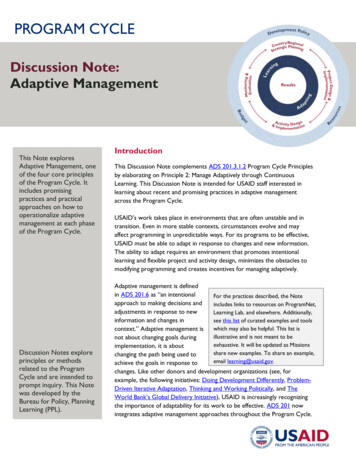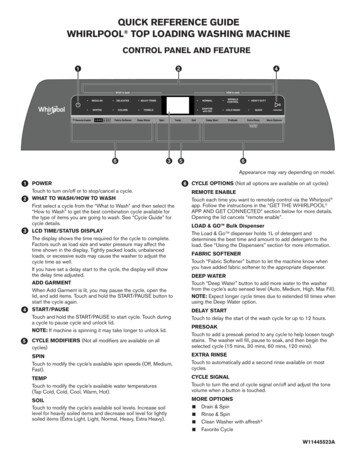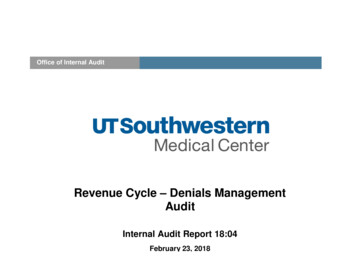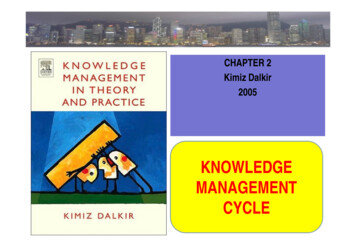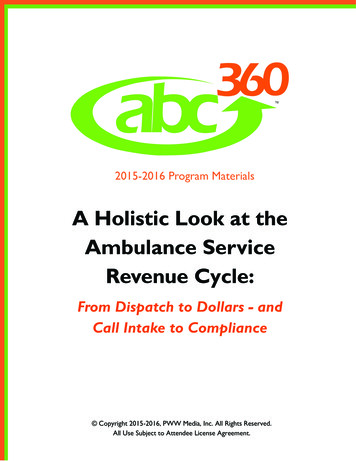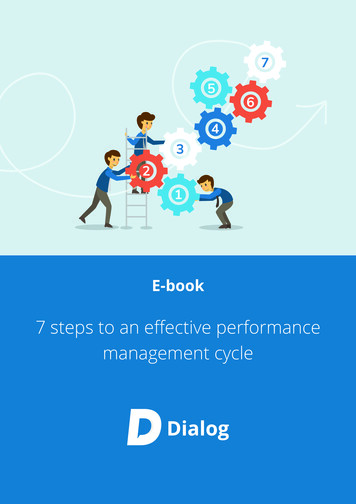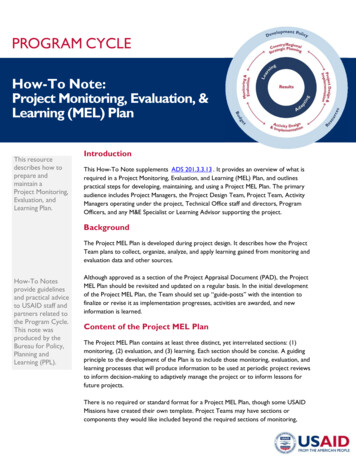
Transcription
PROGRAM CYCLEHow-To Note:Project Monitoring, Evaluation, &Learning (MEL) PlanThis resourcedescribes how toprepare andmaintain aProject Monitoring,Evaluation, andLearning Plan.IntroductionThis How-To Note supplements ADS 201.3.3.13 . It provides an overview of what isrequired in a Project Monitoring, Evaluation, and Learning (MEL) Plan, and outlinespractical steps for developing, maintaining, and using a Project MEL Plan. The primaryaudience includes Project Managers, the Project Design Team, Project Team, ActivityManagers operating under the project, Technical Office staff and directors, ProgramOfficers, and any M&E Specialist or Learning Advisor supporting the project.BackgroundThe Project MEL Plan is developed during project design. It describes how the ProjectTeam plans to collect, organize, analyze, and apply learning gained from monitoring andevaluation data and other sources.How-To Notesprovide guidelinesand practical adviceto USAID staff andpartners related tothe Program Cycle.This note wasproduced by theBureau for Policy,Planning andLearning (PPL).Although approved as a section of the Project Appraisal Document (PAD), the ProjectMEL Plan should be revisited and updated on a regular basis. In the initial developmentof the Project MEL Plan, the Team should set up “guide-posts” with the intention tofinalize or revise it as implementation progresses, activities are awarded, and newinformation is learned.Content of the Project MEL PlanThe Project MEL Plan contains at least three distinct, yet interrelated sections: (1)monitoring, (2) evaluation, and (3) learning. Each section should be concise. A guidingprinciple to the development of the Plan is to include those monitoring, evaluation, andlearning processes that will produce information to be used at periodic project reviewsto inform decision-making to adaptively manage the project or to inform lessons forfuture projects.There is no required or standard format for a Project MEL Plan, though some USAIDMissions have created their own template. Project Teams may have sections orcomponents they would like included beyond the required sections of monitoring,
evaluation, and learning.The following sections outline requirements andrecommendations for content to be included in theProject MEL Plan.INTRODUCTION (Recommended)An introduction enables the Project MEL Plan to act asa standalone management tool for the Project Team.This section introduces the Project MEL Plan, outlinesthe structure of the Plan, and describes its intendeduse. The Project Team may also decide to include theproject logic model with explanation of the keymonitoring, evaluation, or learning efforts discussed inthe Plan, and how they relate to each other. Forexample, results and assumptions highlighted in thelogic model might be paired with the indicatorsselected to monitor those results and assumptions.Likewise, the introduction may show how key learningand evaluation questions relate to specific aspects ofthe logic model.MONITORING SECTION (Required)PMPs, Project MEL Plans,and Activity MEL PlansPerformance Management Plan (PMP) isdeveloped by a Mission following CDCS approvalto monitor, evaluate, and learn from the strategy.Project MEL Plan is developed by a USAID teamduring project design to monitor, evaluate, and learnfrom a USAID project.Activity MEL Plan is typically developed by animplementing partner following award to monitor,evaluate, and learn from a USAID activity.Each plan serves a distinct management purpose,but they are related and should be congruent, withsome information appearing in multiple plans. Forinstance, a performance indicator may haverelevance for, and appear in, all three plans; anevaluation planned during project design mayappear in both a Project MEL Plan and the PMP; orlearning questions that emerge during CDCSdevelopment may appear in all three plans.Information should not simply be duplicated in allplans, but should only be included as necessary. Forexample, an indicator that is useful for a project andan activity does not need to appear in a PMP.The monitoring section describes how the project willmonitor both performance and context. Performancemonitoring tracks progress toward planned results defined in the logic model. Context monitoring tracksthe assumptions or risks defined in the logic model. In other words, it monitors the conditions beyond theproject’s control that may affect implementation.Performance Monitoring IndicatorsThe monitoring section must include at least one performance indicator to monitor progress toward theachievement of the Project Purpose, the key result to be achieved by the project. If the Project Purpose isaligned to a result in the Country Development Cooperation Strategy (CDCS) Results Framework, such asan Intermediate Result (IR), for example, then the same indicator(s) should monitor the achievement of boththe Project Purpose and the Results Framework result to which it is aligned. During the project designprocess, indicators that were identified during CDCS development are often revised. The Project MEL Planincludes the current indicator(s), and the PMP is revised to include the updated indicator(s).The monitoring section also includes other key project performanceindicators that are necessary to monitor progress toward achievementof expected project outcomes below the Project Purpose. ADS 201states that such key project performance indicators should measureoutcomes that are (1) relevant – i.e., related to the project’s logicmodel and (2) significant – i.e., an important outcome in the chain ofresults that lead to the Project Purpose.VERSION 2 / MARCH 2017Helpful HintFor a typical project, the CDCSsub-IRs are likely to be significantand relevant outcomes to monitorfor project management.PAGE 2
ADS 201 provides considerable discretion to the Project Team to decide which results should be monitoredby performance indicators and how many performance indicators to include in the Project MEL Plan. Notevery expected result described in the project design or depicted in a project logic model requires anassociated performance indicator. Nor should every activity-level indicator from MEL Plans of activitiesunder the project be included in the Project MEL Plan. Other than the required Project Purpose indicator, aProject Team should decide which performance indicators that they deem most necessary for managing theproject. Some intermediate outcomes may be particularly difficult to monitor and some indicators may betoo costly to track relative to their benefits. Additionally, indicators are not always the best approach formonitoring intended results. In some circumstances, outcomes may be more appropriately monitoredthrough tracking of milestones, site visits, key stakeholder interviews, and periodic qualitative monitoringreports (as discussed below in the “Other Monitoring Efforts” section).For example, a Mission may design a project that has a Project Purpose to “increase farmer incomes.” In thisexample, the Project Team expects that by training farmers in new technologies, farmers will adopt the newtechnology and farmers’ yields will increase, leading to increased farmer incomes. The MEL Plan for thisproject must include an indicator of farmer incomes because it is the Project Purpose. The Project Teammay also choose to track the farmer yields, as this result is both significant and relevant for achieving theProject Purpose. The farmers’ adoption of new technology is also relevant to the Project Purpose; however,the Project Team may choose not to monitor this result if it is cost prohibitive to do so, or may usequalitative monitoring approaches, such as interviewing a representative sample of farmers on theirexperiences related to adopting new technology.Outcome indicators are typically better suited than output indicators to include in a Project MEL Plan.However, there are times when including output indicators in a Project MEL Plan may be useful for projectmanagement, including: Data for the output indicator are being collected by multiple activities; The outputs are particularly important to determining the progress of the project as a whole; The indicator is of particular interest to Mission management, Congress, local partners andstakeholders, or it is required to be included in the Performance Plan and Report (PPR).Recognizing the interdependence of the Project MEL Plan to the Activity MEL Plans, Project Teams will needto plan to coordinate indicator data collection and analysis across multiple activities as monitoring theprogress toward some project-level results may require aggregating indicator information across differentimplementing mechanisms.Once indicators have been selected, it is useful to summarize them in atable that can provide the required information on baseline and end-ofproject target values—or a plan for collecting baselines and settingtargets—for each indicator. A summary table should include the full setof performance and context indicators, linked to the correspondingresult. The Monitoring Toolkit has a sample template for a PerformanceIndicator Summary Table.Helpful HintAssessments and analyses collected toinform project design may also informthe indicators used in the Project MELPlan. In these cases, baseline data mayhave already been collected, and aProject Team may also use theresearch to inform target setting.Indicator Reference InformationFor each performance indicator selected, indicator reference information must be developed and stored soVERSION 2 / MARCH 2017PAGE 3
that it is accessible to all Mission staff and implementing partners. Such information is typically stored in aPerformance Indicator Reference Sheet (PIRS). A PIRS helps ensure reliable data collection and use overtime and across partners. A PIRS must be completed for all performance indicators within three months ofthe start of indicator data collection.For all indicators included in the PMP and already in use, a PIRS should have been previously developed. Forany new indicator developed during project design, the Project Team will need to develop the PIRS. PIRSs donot need to be included in the Project MEL Plan. However, wherever they are stored, they must be easilyaccessible to the Project Team and anyone else who will be collecting or using the indicators, such as activityimplementing partners. For more information, see Guidance and Template for a PIRS.Indicator Baselines and TargetsPrior to PAD approval, all performance indicators must have a baseline value and date of baseline datacollection, unless it is not feasible to collect baseline data prior to PAD approval. In such cases, the ProjectMEL Plan must clearly specify a plan for collecting remaining baseline data.All performance indicators must also have a documented end-of-project target and rationale for that target,prior to PAD approval except in cases where further analysis is needed before setting targets. In thosecases, the Project MEL Plan must document the plan for setting these targetsIt is recommended that the Project Team set targets in time periods that are useful for project management,which may vary in frequency. If any of the indicators are planned to be reported in the PPR, annual targets ata minimum should be set. Find more information about collecting baselines and setting targets in theMonitoring Toolkit.Context MonitoringThe Project Team should plan to use context monitoring (including specific context indicators) to monitorthe assumptions and risks identified in the project logic model. Context refers to the conditions and externalfactors relevant to implementation of USAID strategies, projects, and activities. Context includes theenvironmental, economic, social, or political factors that may affect implementation, as well as how localactors, their relationships, and the incentives that guide them affect development results.If context indicators are to be included as part of the Project MEL Plan it is useful to document a baseline forthe context indicators. While targets are not set for context indicators, the Project Team may want toestablish “triggers,” i.e., a value or threshold, which if crossed would prompt an action, for contextindicators. Meeting or not meeting the threshold for a trigger could lead to closer inspection of assumptions,prompt certain actions on the part of the Mission, or be used to inform decisions. For example, anagricultural project may monitor “amount of rainfall.” A Project Team may set two triggers for this indicatorto watch out for excessive or insufficient amounts of rainfall. Excessive rainfall could cause crops to rot,while insufficient rainfall could cause crop failure without additional inputs. Exceeding the high trigger or notmeeting the low trigger would each affect project outcomes, and the Project Team might have to pivotimplementation to respond to the changing context. A Context Indicator Reference Sheet (CIRS) isrecommended for each context indicator.Other Monitoring EffortsAny other planned efforts for monitoring progress toward achievement of intended project outcomes (e.g.,VERSION 2 / MARCH 2017PAGE 4
site visits, key stakeholder interviews, periodic qualitative monitoring reports, etc.) must be described in theProject MEL Plan. The Project MEL Plan may also include: Information about the purpose of each described effort; The expected result(s) each effort will monitor; The expected timeframe for when it will occur; Who will be involved (i.e., which activities, partners, beneficiaries, and USAID staff, as well asrelevant host country counterparts and other donors); and What actions may result from the findings (i.e., the intended use for the data).Where appropriate and feasible, the monitoring section notes how project monitoring aligns with indicatorsand data systems in use by host country counterparts and other donors in the relevant sector. The ProjectTeam may consider working with their regional bureau or USAID/Washington pillar bureau to incorporatebest practices for monitoring in specific sectors.Managing Project Indicator DataADS 201.3.5.7 states that performance indicator data must be stored in an indicator tracking table ormonitoring information system. This includes the baseline values, the baseline timeframe, targets and actualvalues. Indicator data in tracking tables or information systems must be updated per the reporting frequencyset in the PIRS for each indicator. A monitoring information system that serves as a centralized repositoryfor indicators identified in a Mission-wide PMP and Project and Activity MEL Plans is recommended overseparate and decentralized tracking tables.It may be useful to include in the monitoring section of the Project MEL Plan a brief description or plan tosupport data collection, storage, security, and quality. Some examples might include: defining a geographicboundary by which all data will be disaggregated, drafting a protocol to ensure proper data storage andsecurity, and scheduling any Data Quality Assessments (DQAs) to be conducted at regular intervals. Moreinformation about all of these subjects is included in the Monitoring Toolkit.EVALUATION SECTION (Required)The evaluation section describes all anticipated evaluations relevant to the project and can be used to trackevaluations over the project’s timeframe. Project design is an appropriate time to begin thinking aboutevaluations, including those that focus beyond the scope of individual activities and attempt to incorporateaspects related to the overall management of the project. These types of evaluations may include: The project’s theory of change; Issues that cut across activities; Local ownership and sustainability of results achieved after the end of the project; and The extent to which projects or supportive activities have transformed gender norms and reducedgender gaps for men and women across diverse groups.The purpose of evaluations is twofold: to ensure accountability to stakeholders and to learn in order toimprove development outcomes. Evaluation is the systematic collection and analysis of information aboutthe characteristics and outcomes of strategies, projects, and activities conducted as a basis for judgements toVERSION 2 / MARCH 2017PAGE 5
improve effectiveness and timed to inform decisions about current and future programming. Evaluations aredistinct from assessments or informal reviews of projects. Evaluations may be performance or impact;conducted internally or by an external evaluation team; and may be conducted at the midterm of project oractivity, at the end of the project or activity, or even after a project or activity has ended.Evaluations may generate evidence to answer questions that represent gaps in knowledge that cannot beanswered readily by other means (analyzing monitoring data, for example). Evaluations may focus on one ormore activities within a project, or on the project as a whole. The evaluation section is an opportunity forthe Project Team and Program Office to determine how evaluations can inform learning and managementneeds. There are three requirements that trigger when or how to conduct an external evaluation, all ofwhich involve decisions that are best discussed during project design.1. One Evaluation per Project: Each Mission must conduct at least one evaluation per project. Thisevaluation could address the project as a whole, a single activity, a set of activities within the project, ora crosscutting issue within the project.2. Impact Evaluation for Pilot Approaches: An impact evaluation must be conducted of any new,untested approaches that are anticipated to be expanded in scale or scope. If it is not feasible toeffectively undertake an impact evaluation, then the Project Team must document why an impactevaluation was not feasible, and must conduct a performance evaluation of the pilot intervention.3. Whole-of-Project Evaluation: Each Mission must conduct at least one “whole-of-project”performance evaluation within their CDCS timeframe. A whole-of-project evaluation examines theentire project, including all its constituent activities, and progress toward the achievement of the ProjectPurpose. See ADS 201 Additional Help: Whole-of-Project Evaluation.Both an impact evaluation to examine a pilot approach and a whole-of-project evaluation meet therequirement of one evaluation per project.The Project MEL Plan approved with the PAD must identify anddescribe any evaluations that will be conducted to fulfill the “oneevaluation per project” requirement, identify any impact evaluationsfor pilot approaches, and identify if the project will be subject to awhole-of-project evaluation.A summary description of each planned evaluation should beincluded in the Project MEL Plan. Each planned evaluation shouldinclude the following information: name of the project or activity tobe evaluated, evaluation purpose and expected use, evaluation type(performance or impact), possible evaluation questions, whether it isexternal or internal, ADS 201 required evaluation or not, estimatedbudget, planned start date, and estimated completion date. See theMulti-Year Evaluation Plan Summary and Schedule Template formore guidance. Any external evaluation must be managed by theProgram Office, so it is good practice for the Project Team toconsult with the Program Office at this early stage.VERSION 2 / MARCH 2017Collaborate with Local PartnersThe Project Team may consider engaginglocal partners in the evaluation section.This could include collaborating on thedevelopment of the design anddissemination of the evaluation, amongother efforts. Such collaboration can serveto ensure relevancy of evaluationquestions and buy-in of evaluation findingsand recommendations. Partners toconsider engaging include beneficiaries,local stakeholders, other donors, and thecountry government. If the Project Teamplans to partner with the countrygovernment through a Government-toGovernment (G2G) Agreement, refer tothe ADS 201 Additional Help: Monitoring& Evaluation for a G2G Agreement.PAGE 6
Evaluation planning should also include considerations of methodologies, timing, and stakeholderengagement. It is particularly important that expected impact evaluations be identified when developing theProject MEL Plan to ensure the evaluation will be implemented in parallel with the intervention. For moreinformation on impact evaluations, see Technical Note: Impact Evaluation. Evaluation efforts, includingproject level baseline, midterm, and end line data collection, also require close collaboration withimplementing partners and affect related activity procurement documents. Further planning for closecollaboration with key stakeholders helps ensure evaluation findings are communicated in a timely manner.During project implementation, unexpected events may occur or new information may become available thatlead to a decision to conduct an evaluation. A Project Team should consider what events or informationmight trigger conducting a previously unplanned evaluation and include these triggers in their Project MELPlan. Such triggers might be a change in the host country context, large deviations of indicator results fromtargets, or changes in project assumptions or risks, among others. For more information, see ADS 201Additional Help: Evaluation Triggers.To ensure sufficient advance planning so that evaluations can be timed to inform upcoming decisions,consider drafting a timeline of anticipated evaluations, including not only the timeframe to implement theevaluations, but also key dates related to designing, procuring, and utilizing evaluations. Include EvaluabilityAssessments in the timeline if they are to be conducted. Other timing considerations include planning forcollecting baseline data before the launch of an activity or project and ensuring enough time for the evaluatorto design and test data collection instruments. The Evaluation Toolkit has a sample template to use for aMulti-Year Evaluation Plan Summary and Schedule.Project Teams should also consider an estimated budget and source of funds for each planned evaluation.ADS 201.5.13 recommends Missions and Washington OUs devote an average of 3 percent of total programfunding to external evaluations. For more information about planning, managing, conducting, and usingevaluations, see the Evaluation Toolkit.LEARNING SECTION (Required)The section on learning discusses how the Project Team will work with partners and stakeholders to learnfrom the project and its activities throughout implementation and act on that learning to adaptively managethe project.The learning section may also identify: Learning questions based on the project’s logic model; Plans for addressing those questions through performance monitoring, evaluations, or other means,such as research or analyses; Other opportunities to facilitate collaborative learning among USAID, implementing partners, andstakeholders (such as through learning networks, pilot activities, peer assists, or communities ofpractice) that would be used to explore gaps in knowledge; Plans for tracking potential contextual issues and how the project will be adapted to adjust; Opportunities to reflect on performance and the context, such as project reviews or partnermeetings; Plans to engage local stakeholders and implementing partners to share knowledge and experience; andVERSION 2 / MARCH 2017PAGE 7
How the Project Team intends to use monitoring, evaluation, and learning data to informadaptations to the project and its activities.The Project MEL Plan’s learning section should reflect relevant information from the CLA Plan in the PMP,and be structured in a way to ensure that activities contribute to the project’s learning needs. For moreinformation about methods and uses for collaborating, learning, and adapting see the CLA Toolkit .Missions and Washington OUs must also consider funding requirements for monitoring, evaluation, and learningefforts outside of programmatic activities and account for them accordingly in the Project Financial Plan .ROLES & RESPONSIBILITIES (Recommended)The process of developing and using a Project MEL Plan is a team effort. In some cases, including a sectionabout roles and responsibilities can clarify who needs to be engaged, how, and when. A roles andresponsibilities section may be particularly useful when the Mission has an external M&E support contract.This helps to ensure consistent application of the MEL Plan and promotes institutional memory. The ProjectMEL Plan may describe roles and responsibilities of the Project Team and implementing partners regardingany monitoring, evaluation, and learning efforts that involve multiple activities within the project. For moreinformation on required and suggested roles and responsibilities in monitoring, evaluation, and learning, seeStaff Roles and Responsibilities in Monitoring, Evaluation and Learning.Recommended Steps for Developing the Project MEL PlanThis section provides step-by-step recommendations for the Project Team when developing the initialProject MEL Plan that will be approved in the PAD.BEFORE GETTING STARTEDWhen developing the Project MEL Plan, the Project Team should consult the following key documents:Mission-wide PMP: The alignment of the Project Purpose to a result in the CDCS Results Frameworklinks the Project MEL Plan to the Mission-wide PMP. As such, the Project MEL Plan should reflect thepriorities and information needs described in the PMP. If the Project Team revises indicators, makes updatesto an evaluation plan, or changes any learning approach relevant to the CDCS and PMP, this should promptan update to the PMP. For more information, see the How-To Note: Prepare and Maintain a PerformanceManagement Plan.Project Assessments or Analyses: Any assessments or analyses conducted to inform project designshould be reviewed when developing the Project MEL Plan. Analyses and assessments may help in identifying:potential learning questions; information to incorporate into a collaboration map, or a graphic depictingUSAID’s relationships with key stakeholders; aspects and underlying assumptions of the theory of change toevaluate; performance indicators of expected results; baseline data for performance indicators; contextindicators to monitor any critical assumptions or risks; and other key information to adaptively manage theproject.Activity MEL Plans: If there are activities already being implemented that align to the project, then existingActivity MEL Plans should contribute to the development of the Project MEL Plan. Information from theVERSION 2 / MARCH 2017PAGE 8
Activity MEL Plan that may be relevant to the Project MEL Plan includes: outcome indicators that align to theproject logic model, output indicators that are useful to the Project Team’s management, planned or ongoingevaluations, and learning efforts that extend beyond the scope of the activity. See the How-To Note:Activity MEL Plan for more information on developing, reviewing, and maintaining an Activity MEL Plan.Previous Project Documentation: If this is a follow-on project, review documentation from the previousproject (e.g., the previous Project MEL Plan, a closeout report, any evaluations of the project) and includeindicators and other information that continue to be relevant.Documentation of Host Country and Other Donor Performance Management Information:Where possible, USAID should align its monitoring, evaluation, and learning efforts with partner countrycounterparts and other donors to promote local ownership and sustainability.Previous PPR and the set of Standard Foreign Assistance Indicators: The Mission’s previous PPRand the list of standard foreign assistance indicators may include indicators that are relevant to themanagement of the project.DRAFTING THE PROJECT MEL PLAN1. Revisit the Project Logic Model: The Project Team should revisit the project design and the projectlogic model and consider how monitoring, evaluation, and learning efforts may track results, checkassumptions, and test the project’s theory of change.2. Identify Knowledge Gaps, Learning Questions, and Opportunities for Collaboration andAdapting: Draft learning questions that address any knowledge gaps in the project logic model.Prioritize and plan for how to answer questions. These questions may be linked to and answered byplanned monitoring, evaluation, or other efforts. Consider opportunities for collaboration and adapting.For example, plan for stakeholder identification and collaboration and consider creating a “collaborationmap” that identifies stakeholders and outlines how the Project Team plans to engage and collaboratewith implementing partners, local governments, beneficiaries, and others during implementation. Plan forother CLA efforts that will take place during implementation, including opportunities to review and usemonitoring data, evaluation findings, and other learning to adapt the project and to engage with projectstakeholders on the findings.3. Select and Refine Performance and Context Monitoring Indicators: For performancemonitoring, identify the key results that will require performance monitoring indicators for managementor reporting purposes. Review the illustrative indicators identified in the PMP relating to the project aswell as “required as applicable” standard foreign assistance indicators that may apply. For any ongoingactivity that is being aligned to the project, review the Activity MEL Plan and consider if any outcomeindicators are relevant and useful for project management and should be included in the Project MELPlan. Based on the project design and logic model, and informed by the analyses conducted prior toproject design, the Project Team should determine whether to retain these indicators, refine, or developnew indicators.For context monitoring, identify the key assumptions in the project theory of change that need to bemonitored. Consider other contextual fact
Recognizing the interdependence of the Project MEL Plan to the Activity MEL Plans, Project Teams will need to plan to coordinate indicator data collection and analysis across multiple activities as monitoring the progress toward some project-level results may require aggregating indicator information across different implementing mechanisms.


